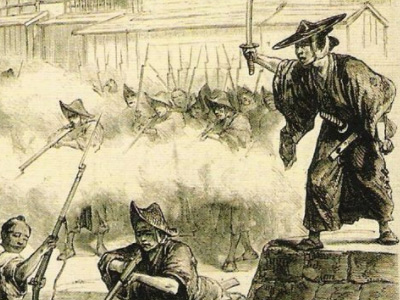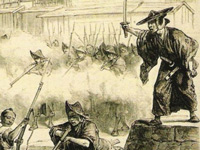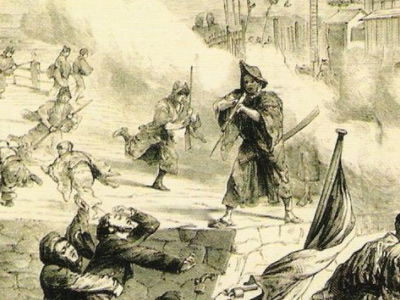Boshin War (1868-1869)

Hokkaidō Campaign
Creation of the Ezo Republic
Following defeat on Honshū, Enomoto Takeaki fled to Hokkaidō with the remnants of the navy and his handful of French advisers. Together they organized a government, with the objective of establishing an independent island nation dedicated to the development of Hokkaidō. They formally established the Republic of Ezo on the American model, Japan's only ever republic, and Enomoto was elected as President, with a large majority. The republic tried to reach out to foreign legations present in Hakodate, such as the Americans The United States of America (U.S.A. or USA), commonly known as the United States (U.S. or US) or America, is a country in North America. It is the world's third-largest country by both land and total area. The United States shares land borders with Canada to its north and with Mexico to its south. The national capital is Washington, D.C., and the most populous city and financial center is New York City., French
The United States of America (U.S.A. or USA), commonly known as the United States (U.S. or US) or America, is a country in North America. It is the world's third-largest country by both land and total area. The United States shares land borders with Canada to its north and with Mexico to its south. The national capital is Washington, D.C., and the most populous city and financial center is New York City., French Second French Empire was the 18-year Imperial Bonapartist regime of Napoleon III from 14 January 1852 to 27 October 1870. The Second Empire is given high credit for the rebuilding of Paris with broad boulevards, striking public buildings, and elegant residential districts for upscale Parisians. In international policy, Napoleon III tried to emulate his uncle Napoleon I, engaging in numerous imperial ventures around the world as well as several wars in Europe., and Russians
Second French Empire was the 18-year Imperial Bonapartist regime of Napoleon III from 14 January 1852 to 27 October 1870. The Second Empire is given high credit for the rebuilding of Paris with broad boulevards, striking public buildings, and elegant residential districts for upscale Parisians. In international policy, Napoleon III tried to emulate his uncle Napoleon I, engaging in numerous imperial ventures around the world as well as several wars in Europe., and Russians Russian Empire was an empire and the final period of the Russian monarchy from 1721 to 1917, ruling across large parts of Eurasia. The rise of the Russian Empire coincided with the decline of neighbouring rival powers: the Swedish Empire, the Polish–Lithuanian Commonwealth, Qajar Iran, the Ottoman Empire, and Qing China. Russia remains the third-largest empire in history, surpassed only by the British Empire and the Mongol Empire., but was not able to garner any international recognition or support. Enomoto offered to confer the territory to the Tokugawa Shogun under Imperial rule, but his proposal was declined by the Imperial Governing Council.
Russian Empire was an empire and the final period of the Russian monarchy from 1721 to 1917, ruling across large parts of Eurasia. The rise of the Russian Empire coincided with the decline of neighbouring rival powers: the Swedish Empire, the Polish–Lithuanian Commonwealth, Qajar Iran, the Ottoman Empire, and Qing China. Russia remains the third-largest empire in history, surpassed only by the British Empire and the Mongol Empire., but was not able to garner any international recognition or support. Enomoto offered to confer the territory to the Tokugawa Shogun under Imperial rule, but his proposal was declined by the Imperial Governing Council.
During the winter, they fortified their defenses around the southern peninsula of Hakodate, with the new fortress of Goryōkaku at the center. The troops were organized under a Franco-Japanese command, the commander-in-chief Ōtori Keisuke being seconded by the French captain Jules Brunet, and divided between four brigades. Each of these was commanded by a French non-commissioned officer (Fortant, Marlin, Cazeneuve, Bouffier), and were themselves divided into eight half-brigades, each under Japanese command.
Advertisement

These books are available for download with iBooks on your Mac or iOS device, and with iTunes on your computer. Books can be read with iBooks on your Mac or iOS device.

These books are available for download with iBooks on your Mac or iOS device, and with iTunes on your computer. Books can be read with iBooks on your Mac or iOS device.
( Click image to enlarge)
Final Losses and Surrender
The Imperial navy reached the harbour of Miyako on March 20, but anticipating the arrival of the imperial ships, the Ezo rebels organized a daring plan to seize the Kōtetsu. Led by Shinsengumi commander Hijikata Toshizō, three warships were dispatched for a surprise attack, in what is known as the Battle of Miyako Bay. The battle ended in failure for the Tokugawa side, owing to bad weather, engine trouble and the decisive use of a Gatling gun by Imperial troops against samurai boarding parties.
Imperial forces soon consolidated their hold on mainland Japan, and, in April 1869, dispatched a fleet and an infantry force of 7,000 to Ezo, starting the Battle of Hakodate. The Imperial forces progressed swiftly and won the naval engagement at Hakodate Bay, Japan's first large-scale naval battle between modern navies, as the fortress of Goryōkaku was surrounded with 800 remaining men. Seeing the situation had become desperate, the French advisers escaped to a French ship stationed in Hakodate Bay — Coëtlogon, under the command of Dupetit Thouars — from where they were shipped back to Yokohama and then France. The Japanese requested that the French advisers be given judgement in France; however, due to popular support in France for their actions, the former French advisers in Japan were not punished for their actions.
Enomoto had resolved to fight to the end, and had sent his valuables to his adversary for safekeeping. These included the Naval Codes he had brought back from Holland, which he entrusted to the general of the Imperial troops, Kuroda Kiyotaka, but Otori convinced him to surrender, telling him that deciding to live through defeat is the truly courageous way: "If it's dying you want you can do it anytime." Enomoto surrendered on June 27, 1869, accepting the Meiji Emperor's rule, and the Ezo Republic ceased to exist.
HISTORY

RESOURCES
This article uses material from the Wikipedia article "Boshin War (1868-1869)", which is released under the Creative Commons Attribution-Share-Alike License 3.0.
© Stories Preschool. All Rights Reserved.









